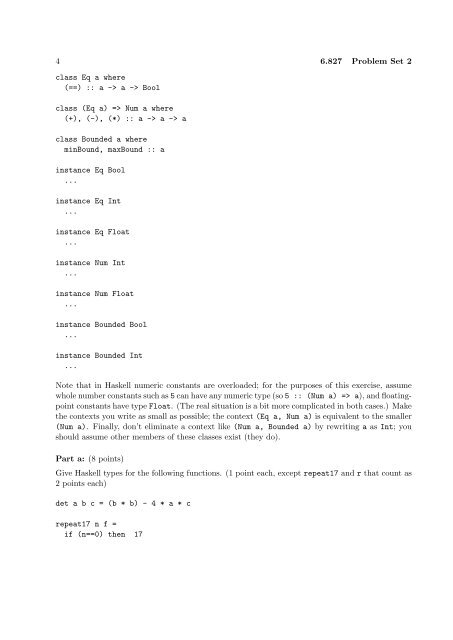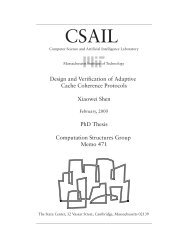Problem Set 2 - MIT
Problem Set 2 - MIT
Problem Set 2 - MIT
Create successful ePaper yourself
Turn your PDF publications into a flip-book with our unique Google optimized e-Paper software.
4 6.827 <strong>Problem</strong> <strong>Set</strong> 2<br />
class Eq a where<br />
(==) :: a -> a -> Bool<br />
class (Eq a) => Num a where<br />
(+), (-), (*) :: a -> a -> a<br />
class Bounded a where<br />
minBound, maxBound :: a<br />
instance Eq Bool<br />
...<br />
instance Eq Int<br />
...<br />
instance Eq Float<br />
...<br />
instance Num Int<br />
...<br />
instance Num Float<br />
...<br />
instance Bounded Bool<br />
...<br />
instance Bounded Int<br />
...<br />
Note that in Haskell numeric constants are overloaded; for the purposes of this exercise, assume<br />
whole number constants such as 5 can have any numeric type (so 5 :: (Num a) => a), and floatingpoint<br />
constants have type Float. (The real situation is a bit more complicated in both cases.) Make<br />
the contexts you write as small as possible; the context (Eq a, Num a) is equivalent to the smaller<br />
(Num a). Finally, don’t eliminate a context like (Num a, Bounded a) by rewriting a as Int; you<br />
should assume other members of these classes exist (they do).<br />
Part a: (8 points)<br />
Give Haskell types for the following functions. (1 point each, except repeat17 and r that count as<br />
2 points each)<br />
det a b c = (b * b) - 4 * a * c<br />
repeat17 n f =<br />
if (n==0) then 17
















